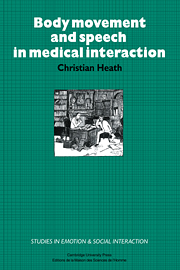Book contents
- Frontmatter
- Contents
- Preface
- The transcription system
- 1 Video analysis: interactional coordination in movement and speech
- 2 The display of recipiency and the beginning of the consultation
- 3 Maintaining involvement in the consultation
- 4 Forms of participation
- 5 The physical examination
- 6 Taking leave of the doctor
- 7 Postscript: the use of medical records and computers during the consultation
- Notes
- References
- Index
6 - Taking leave of the doctor
Published online by Cambridge University Press: 19 January 2010
- Frontmatter
- Contents
- Preface
- The transcription system
- 1 Video analysis: interactional coordination in movement and speech
- 2 The display of recipiency and the beginning of the consultation
- 3 Maintaining involvement in the consultation
- 4 Forms of participation
- 5 The physical examination
- 6 Taking leave of the doctor
- 7 Postscript: the use of medical records and computers during the consultation
- Notes
- References
- Index
Summary
In face-to-face interaction, a whole range of physical doings and positionings, ruled out by the proprieties of maintaining a show of attention and interest, become available and/or required upon termination, for example, those related to leave-taking. In so far as the actions that may be occasioned by termination of the conversation require preparation, there is use for a place in the conversation to prepare for actions that should follow its termination in close order.
Schegloff and Sacks 1973/1974, p. 261On when to go-your exit cues are many. They range from clearcut closing remarks, usually in the form of a “thank you for coming in,” to a vacant and preoccupied stare. But in any case they should come from the interviewer. It should not be necessary for him to stand, abruptly; you should have been able to feel the goodbye in the air far enough in advance to gather up your gear, slide forward to the edge of your chair and launch into a thank-you speech of your own. Nor should it be necessary to ask that embarrassing question, “Am I taking too much of your time?”; if that thought crosses your mind, it's time to go.
Esquire Etiquette 1953, p. 59As we have seen, the medical consultation, like any other form of social interaction, relies upon the participants maintaining some semblance of mutual involvement and thereby coordinating their actions and activities. The interactants encourage each other to attend and participate in certain ways. They accomplish various tasks and implicate subsequent action and activity.
- Type
- Chapter
- Information
- Body Movement and Speech in Medical Interaction , pp. 128 - 152Publisher: Cambridge University PressPrint publication year: 1986
- 3
- Cited by



